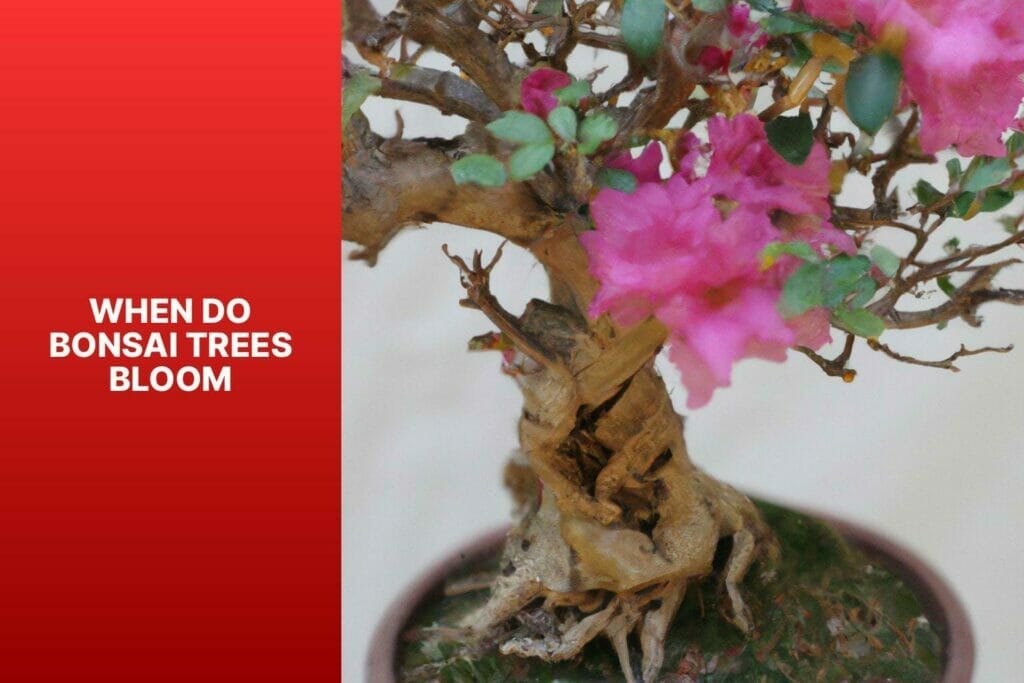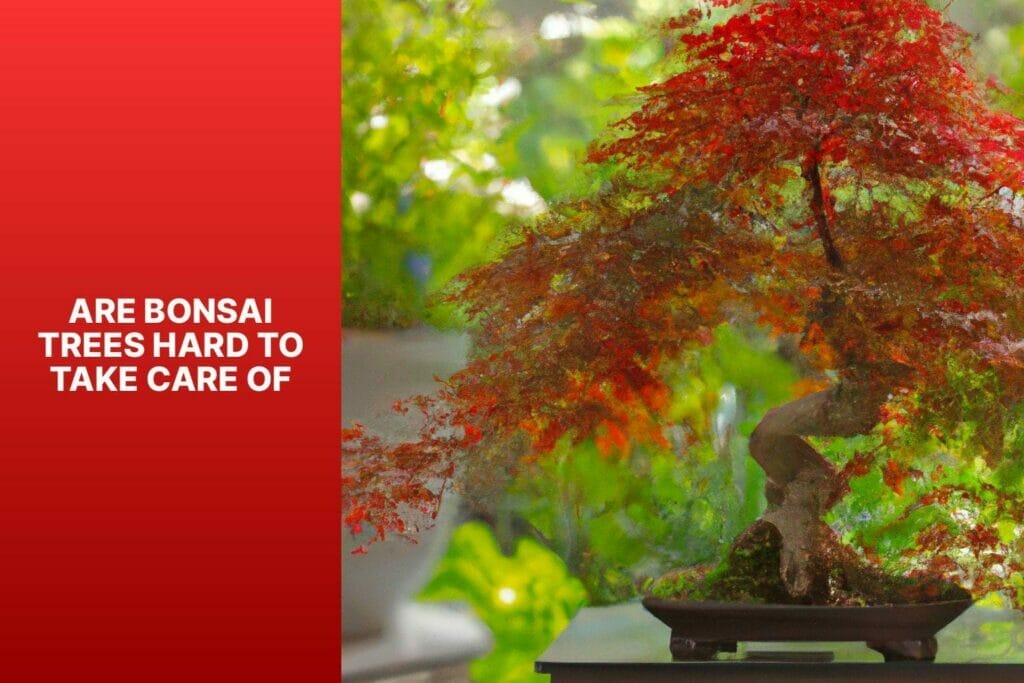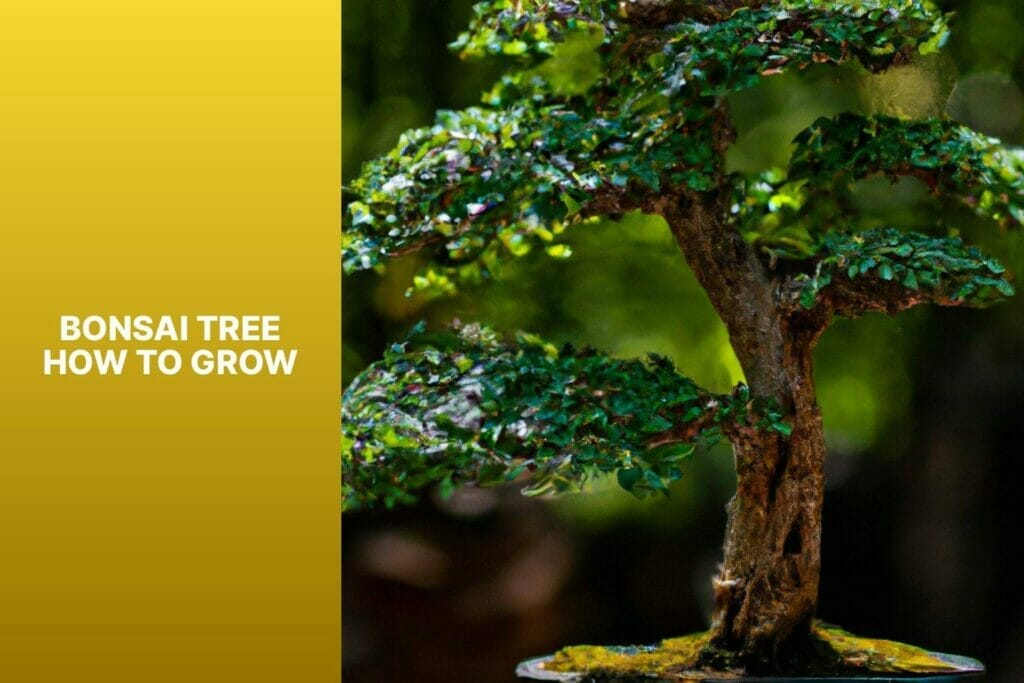Bonsai trees are miniature versions of full-sized trees meticulously cultivated and shaped to resemble their larger counterparts. The art of bonsai originated in Japan and has gained popularity worldwide for its aesthetic appeal and meditative qualities.
One aspect that bonsai enthusiasts often wonder about is the blooming pattern of these miniature trees.
To understand when bonsai trees bloom, it is crucial to grasp the fundamentals of bonsai trees themselves. Bonsai trees are not a specific species but a technique and art form.
They can be created from various tree species, such as Junipers, Pines, Maples, and Cherry Blossoms, to name a few. Each tree species has its unique blooming pattern influenced by several factors.
Identifying the bonsai tree species that bloom is essential to determine when your specific bonsai tree may bloom. Some species are known for their vibrant flowers, while others produce inconspicuous blooms.
Understanding the characteristics of your bonsai tree species will give you insight into its blooming habits.
The timing of bonsai tree blooming can vary depending on various factors, such as the species of the bonsai tree, the geographical location, and the cultural practices followed.
Different tree species have different blooming seasons, some blooming in the spring and others in the summer or even winter.
The environment in which the bonsai tree is kept, such as temperature, humidity, and light exposure, can also affect its blooming time.
Caring for blooming bonsai trees requires specific attention to ensure their health and vitality. Proper watering and fertilization are crucial to provide the necessary nutrients for blooming.
Pruning and shaping techniques help maintain the desired size and form while encouraging blooming. Protecting bonsai trees from pests and diseases is essential to preserve their health and promote optimal blooming.
By understanding the fundamentals of bonsai trees and considering the specific factors that influence their blooming, bonsai enthusiasts can confidently anticipate and care for their blooming trees, creating a visually stunning display of nature’s beauty in miniature form.
Key takeaway:
- Bonsai trees can bloom: Contrary to popular belief, they can bloom just like their larger counterparts. They can produce beautiful flowers, adding to their aesthetic appeal.
- Blooming is influenced by various factors: The blooming pattern of bonsai trees is influenced by factors such as tree species, environmental conditions, and care techniques. Understanding these factors is crucial for encouraging blooming in bonsai trees.
- Proper care promotes blooming: Caring for blooming bonsai trees involves proper watering, fertilizing, Pruning, shaping, and protection against pests and diseases. Providing the right care and attention can enhance the blooming process and ensure the health and vitality of the bonsai trees.
Understanding the Blooming Pattern of Bonsai Trees
Understanding the blooming pattern of bonsai trees is crucial. Bonsai trees have a specific blooming period that varies depending on the type of tree.
Some bonsai trees bloom in spring, while others bloom in summer or fall. Knowing the specific blooming period of your bonsai tree is important for providing the right care and attention.
Research the specific tree species and its natural blooming season to understand the pattern. For example, cherry blossom trees typically bloom in spring, while azalea bonsai trees often bloom in summer.
By studying the natural blooming patterns, you can anticipate when your tree will likely bloom and plan accordingly.
A true story demonstrates the importance of understanding the blooming pattern. Sarah, a bonsai enthusiast, had a juniper bonsai tree that she cared for diligently. When spring arrived, her bonsai tree did not bloom as expected.
Confused, she researched and discovered that juniper bonsai trees do not typically produce flowers. She realized her misunderstanding and could have saved herself some worry by understanding the natural behavior of juniper bonsai trees.
This story illustrates the significance of understanding the blooming pattern. By knowing when to expect blooms, bonsai enthusiasts can ensure they provide appropriate care and attention during the blooming season.
What Are Bonsai Trees?
Bonsai trees are small trees grown in containers and carefully shaped to resemble full-sized trees. What Are Bonsai Trees? They are not a specific type of tree but a technique used to create and maintain artistic plants. The art of bonsai originated in China and was refined by the Japanese.
To thrive, bonsai trees need regular care and maintenance. They require regular watering, sufficient sunlight, and appropriate fertilization.
Pruning and shaping techniques are used to maintain the desired form and size of the tree. Bonsai trees can be grown from seeds or cuttings and can live for many years with proper care.
The purpose of growing bonsai trees is to create a living work of art. These small trees bring tranquility and beauty to any space, requiring skill and dedication to maintain their appearance.
Bonsai trees are commonly used in traditional Japanese gardens and are popular as indoor plants.
What Factors Influence the Blooming of Bonsai Trees?
Factors that influence the blooming of bonsai trees include health and vigor, proper care and maintenance, environmental conditions, and the specific species.
1. Health and vigor: A well-nourished bonsai tree is more likely to bloom. Proper watering, fertilizing, and pruning techniques are essential for maintaining overall tree health and promoting blooming.
2. Care and maintenance: Adequate sunlight, temperature, and humidity levels are crucial for bonsai tree blooming. Providing the right conditions and protecting trees from extreme temperatures or stressors can positively influence blooming.
3. Environmental conditions: The natural growing environment of a bonsai tree species plays a significant role in its blooming. Some trees require specific light amounts or temperature ranges to initiate blooming.
4. Species-specific factors: Different bonsai tree species have unique blooming requirements. Some trees may need a specific dormancy period or exposure to cooler temperatures to stimulate blooming.
Understanding these factors and providing appropriate care and conditions can greatly enhance the likelihood of blooming in bonsai trees. By cultivating healthy and well-maintained trees while considering their specific species’ needs and environmental conditions, bonsai enthusiasts can enjoy their bonsai trees’ beautiful and captivating blooms.
Types of Bonsai Trees That Bloom

Photo Credits: Mnbonsainetwork.Com by Russell Perez
Are you looking to add a touch of blossoming beauty to your bonsai collection? In this section, we’ll focus on the types of bonsai trees that bloom, providing insights into the world of vibrant petals and captivating fragrances.
As we uncover the key characteristics and tips for identifying these blooming wonders, get ready to explore the diverse range of bonsai tree species that radiate with blossoms.
Identifying Bonsai Tree Species That Bloom
To properly identify bonsai tree species that bloom, consider the following options. The Flowering Cherry Tree (Prunus serrulata) is one such species. It showcases lovely pink or white blossoms that bloom in the early spring.
Another bonsai tree that blooms is the Japanese Wisteria (Wisteria floribunda). Its delicate flowers exude a wonderful fragrance and come in a soothing lavender hue.
You can expect them to appear elegantly hanging from the branches in late spring or early summer.
Azaleas (Rhododendron spp.) are also a popular choice for bonsai enthusiasts. They offer a variety of colors to choose from, including pink, red, white, and purple. Expect these colorful blooms to flourish in spring or early summer.
Camellias (Camellia japonica), on the other hand, provides an array of beautiful colors, such as white, pink, and red. Their blooming period usually occurs in late winter to early spring.
The Flowering Quince (Chaenomeles spp.) is a bonsai tree that produces vibrant flowers in shades of orange, red, or pink. They brighten your collection during late winter or early spring, creating a stunning contrast against the bare branches.
By identifying bonsai tree species that bloom, you can select ones that perfectly align with your aesthetic preferences and desired blooming season.
Remember to provide the necessary care and follow appropriate techniques to ensure your bonsai trees’ thriving and beautiful bloom.
When Do Bonsai Trees Bloom?
Curious about when bonsai trees burst into vibrant blooms? Join me as we uncover the secrets of bonsai tree blooming. We’ll explore the fascinating world of seasonal variations, uncover the factors that sway their bloom time, and learn how to care for these delicate blossoms.
So, if you’re a bonsai enthusiast or have a green thumb, get ready to dive into the enchanting realm of blooming bonsai trees!
Seasonal Variations in Bonsai Tree Blooming
Seasonal variations in bonsai tree blooming can be categorized into spring, summer, fall, and winter. Different bonsai tree species have varying blooming patterns throughout the year.
| Season | Blooming Bonsai Tree Species |
| Spring | Cherry Blossom, Wisteria, Azalea |
| Summer | Hibiscus, Bougainvillea, Tree of a Thousand Stars |
| Fall | Japanese Maple, Trident Maple, Pomegranate |
| Winter | Camellia, Chinese Elm, Dwarf Gardenia |
These are some examples of bonsai tree species blooming during different seasons. The specific blooming time can vary depending on climate and growing conditions.
Proper care and maintenance are essential throughout the year to ensure optimal blooming. This includes watering and fertilizing the bonsai trees according to their specific needs and Pruning and shaping techniques to promote healthy growth and flowering.
Protecting the bonsai trees from pests and diseases is crucial to maintain their blooming potential.
By understanding the seasonal variations in bonsai tree blooming and tailoring your care accordingly, you can enjoy the beauty of blooming bonsai trees all year round.
Factors Affecting the Blooming Time of Bonsai Trees
Several factors influence the blooming time of bonsai trees.
1. Light exposure: Bonsai trees need sunlight to bloom. The light they receive can affect when and how long they bloom.
2. Temperature: Temperature determines when bonsai trees will bloom. Different species have specific temperature requirements for blooming, and seasonal variations can impact their blooming time.
3. Watering and fertilizing: Proper watering and fertilizing are essential for bonsai trees’ healthy growth and blooming. Providing the right amount of water and nutrients at the appropriate times can promote blooming.
4. Pruning and shaping: Pruning and shaping techniques can also affect the blooming time of bonsai trees. Regular Pruning helps maintain the tree’s shape and encourages the development of new buds, which can lead to blooming.
5. Health and care: The overall health and care of the bonsai tree can impact its ability to bloom. Stressed, diseased, or poorly cared for trees may experience delayed or reduced blooming.
By considering these factors, bonsai enthusiasts can create optimal conditions to encourage the blooming of their trees.
Ensuring adequate light exposure, providing appropriate temperature, implementing proper watering and fertilizing techniques, and practicing regular Pruning and care can all contribute to a vibrant and timely blooming display for bonsai trees.
Caring for Blooming Bonsai Trees
Caring for blooming bonsai trees involves proper watering, fertilizing, Pruning, protecting from pests and diseases, providing suitable lighting and temperature, and regular maintenance.
Watering and fertilizing are important aspects of caring for blooming bonsai trees. Providing adequate water to keep the trees hydrated is essential, ensuring moist soil is not waterlogged.
Following the label instructions, fertilizing with balanced bonsai fertilizer provides the necessary tree nutrients.
Pruning and shaping techniques play a crucial role in maintaining the desired form of the bonsai trees and promoting blooming.
Regular Pruning helps remove dead or damaged branches and trim excessive growth. It is important not to prune too heavily, as it may hinder the blooming process.
Keeping a close eye on them is important to protect blooming bonsai trees from pests and diseases. Regularly inspecting the leaves and branches helps identify signs of pests or diseases.
If issues arise, appropriate action should be taken, such as using organic insecticides or pesticides and following the instructions carefully.
Providing proper lighting and temperature is crucial for blooming bonsai trees. These trees require the right amount of sunlight, so placing them where they can receive adequate direct or indirect sunlight is important.
Ensuring the temperature is suitable for the specific species is important. Some bonsai trees thrive in cooler environments, while others prefer warmer conditions.
Regular maintenance is essential for blooming bonsai trees. Regular maintenance includes checking the tree’s health regularly, removing dead leaves or flowers, and gently cleaning the foliage with a soft brush.
Monitoring soil moisture levels and adjusting watering as needed is also important. Consistent care and attention will ensure healthy blooms for the bonsai trees.
Following these guidelines and incorporating proper care, your blooming bonsai trees will stay healthy and produce beautiful blooms.
Watering and Fertilizing Blooming Bonsai Trees
Watering and fertilizing are essential practices for promoting the blooming of bonsai trees. Proper watering is crucial as it provides the right moisture for healthy growth and blooming.
To achieve this, it is important to thoroughly water the bonsai, allowing the water to reach the roots and be absorbed.
Watering frequency should be determined based on the bonsai type, pot size, and surrounding environment. Generally, bonsai should be watered when the topsoil feels slightly dry.
Fertilizing is vital in providing the necessary nutrients for blooming bonsai trees. Fertilizers supply essential minerals that contribute to healthy growth and vibrant blooms.
Using liquid or granular fertilizers specifically formulated for bonsai trees is recommended. Bonsai should be fertilized every two to three weeks during the growing season.
It is crucial to follow the instructions on the fertilizer packaging to avoid overfertilization, which can potentially harm the tree.
Here’s a pro tip: when watering blooming bonsai trees, it is advisable to use a watering can with a fine rose or sprayer attachment.
This allows for even water distribution, preventing soil erosion and ensuring water reaches all parts of the bonsai’s root system.
Additionally, organic fertilizers can promote long-term soil health and gradual nutrient release. Regularly monitoring the bonsai’s soil moisture level will help adjust the watering frequency accordingly, ensuring the healthy blooming of bonsai trees.
Pruning and Shaping Techniques for Blooming Bonsai Trees
Pruning and shaping techniques for blooming bonsai trees are of utmost importance. To achieve successful results, follow these steps:
- Begin Pruning in late winter or early spring. This timing ensures better control over the process and promotes healthy growth.
- To maintain overall tree health, remove any dead or damaged branches.
- Trim back long branches by making clean cuts just above a bud or node.
- Improve air circulation and sunlight penetration by thinning out dense areas. This can be achieved by removing small branches or shoots.
- Shape the tree according to your desired style. Utilize techniques such as wiring or clipping to achieve the desired look.
- Engage in regular maintenance pruning throughout the growing season. Continuously monitor and prune the tree to ensure its health and desired appearance.
The art of Pruning and shaping bonsai trees has a rich history. Originating in China and refined by the Japanese, these techniques allow for the creation of stunning living art pieces.
Through meticulous Pruning, bonsai masters can control the tree’s growth and emphasize its best features. Bonsai enthusiasts worldwide continue to practice and refine these techniques, ensuring that future generations can appreciate the beauty of blooming bonsai trees.
Protecting Blooming Bonsai Trees from Pests and Diseases
Regularly inspecting blooming bonsai trees for pests or diseases is crucial to protect their health. Look for insects, leaf discoloration, or unusual growth patterns. Remove pests by hand or with a mild soap solution.
Keeping the area clean and free of weeds and debris is essential to prevent infestations. Use organic insecticides or pesticides sparingly as a last resort, following instructions and taking necessary precautions.
Ensuring proper care for the tree, including watering, fertilizing, and Pruning, is also important. If an infected tree is found, isolate it immediately to prevent the spread of diseases.
Monitor for fungal infections and consult an expert if needed. Provide good air circulation and avoid overwatering to promote the tree’s well-being.
By following these guidelines and promptly addressing any issues, you can protect the blooming bonsai trees and ensure their beauty and vitality.
Some Facts About When Bonsai Trees Bloom:
- ✅ Bonsai trees can produce blooms, go through pollination, and have fruit like regular trees. (Source: plantscraze.com)
- ✅ Not all Bonsai trees are capable of flowering, and those that can require proper care to encourage flowering. (Source: plantscraze.com)
- ✅ Bonsai trees mainly bloom in the Spring and Summer, but the specific time can vary depending on the species. (Source: plantscraze.com)
- ✅ Flowering bonsai trees require specific care regarding sunlight, temperature, watering, and Pruning to thrive and provide beauty to homes and gardens. (Source: bonsaiempire.com)
- ✅ Pruning should be done according to the unique growth patterns of flowering bonsai trees to ensure proper flower development and blooms in the following year. (Source: bonsaiempire.com)


